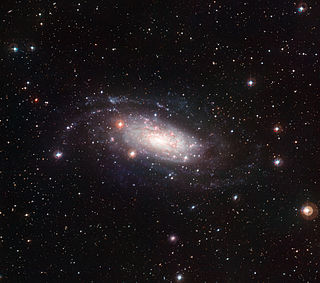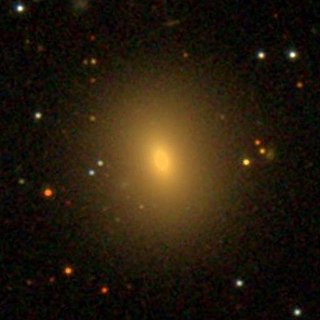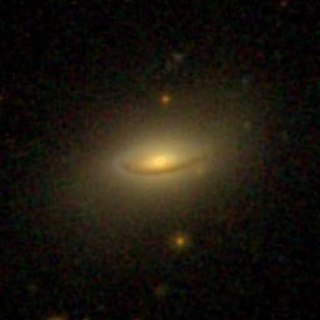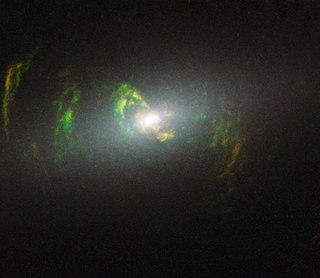Related Research Articles
An active galactic nucleus (AGN) is a compact region at the center of a galaxy that has a much-higher-than-normal luminosity over at least some portion of the electromagnetic spectrum with characteristics indicating that the luminosity is not produced by stars. Such excess, non-stellar emissions have been observed in the radio, microwave, infrared, optical, ultra-violet, X-ray and gamma ray wavebands. A galaxy hosting an AGN is called an active galaxy. The non-stellar radiation from an AGN is theorized to result from the accretion of matter by a supermassive black hole at the center of its host galaxy.

A supermassive black hole is the largest type of black hole, with its mass being on the order of hundreds of thousands, or millions to billions of times the mass of the Sun (M☉). Black holes are a class of astronomical objects that have undergone gravitational collapse, leaving behind spheroidal regions of space from which nothing can escape, not even light. Observational evidence indicates that almost every large galaxy has a supermassive black hole at its center. For example, the Milky Way galaxy has a supermassive black hole at its center, corresponding to the radio source Sagittarius A*. Accretion of interstellar gas onto supermassive black holes is the process responsible for powering active galactic nuclei (AGNs) and quasars.

In astronomy, a galactic bulge is a tightly packed group of stars within a larger star formation. The term almost exclusively refers to the central group of stars found in most spiral galaxies. Bulges were historically thought to be elliptical galaxies that happened to have a disk of stars around them, but high-resolution images using the Hubble Space Telescope have revealed that many bulges lie at the heart of a spiral galaxy. It is now thought that there are at least two types of bulges: bulges that are like ellipticals and bulges that are like spiral galaxies.

NGC 4395 is a nearby low surface brightness spiral galaxy located about 14 million light-years from Earth in the constellation Canes Venatici. The nucleus of NGC 4395 is active and the galaxy is classified as a Seyfert Type I known for its very low-mass supermassive black hole.

NGC 5548 is a Type I Seyfert galaxy with a bright, active nucleus. This activity is caused by matter flowing onto a 65 million solar mass (M☉) supermassive black hole at the core. Morphologically, this is an unbarred lenticular galaxy with tightly-wound spiral arms, while shell and tidal tail features suggest that it has undergone a cosmologically-recent merger or interaction event. NGC 5548 is approximately 245 million light years away and appears in the constellation Boötes. The apparent visual magnitude of NGC 5548 is approximately 13.3 in the V band.

APM 08279+5255 is a very distant, broad absorption line quasar located in the constellation Lynx. It is magnified and split into multiple images by the gravitational lensing effect of a foreground galaxy through which its light passes. It appears to be a giant elliptical galaxy with a supermassive black hole and associated accretion disk. It possesses large regions of hot dust and molecular gas, as well as regions with starburst activity.

NGC 3621 is a field spiral galaxy about 22 Mly (6.7 Mpc) away in the equatorial constellation of Hydra. It is comparatively bright and can be well seen in moderate-sized telescopes. The galaxy is around 93,000 ly (29,000 pc) across and is inclined at an angle of 25° from being viewed edge on. It shines with a luminosity equal to 13 billion times that of the Sun. The morphological classification is SA(s)d, which indicates this is an ordinary spiral with loosely wound arms. There is no evidence for a bulge. Although it appears to be isolated, NGC 3621 belongs to the Leo spur.

NGC 3783 is a barred spiral galaxy located about 135 million light years away in the constellation Centaurus. It is inclined by an angle of 23° to the line of sight from the Earth along a position angle of about 163°. The morphological classification of SBa indicates a bar structure across the center (B) and tightly-wound spiral arms (a). Although not shown by this classification, observers note the galaxy has a luminous inner ring surrounding the bar structure. The bright compact nucleus is active and categorized as a Seyfert 1 type. This nucleus is a strong source of X-ray emission and undergoes variations in emission across the electromagnetic spectrum.

NGC 4102 is an intermediate barred spiral galaxy located in the northern constellation of Ursa Major. It is visible in a small telescope and has an apparent visual magnitude of 11.2. The galaxy was discovered April 12, 1789 by William Herschel. J. L. E. Dreyer described it as "bright, pretty small, round, brighter middle and bright nucleus". This galaxy is located at a distance of 60 million light years and is receding with a heliocentric radial velocity of 837 km/s. It is a member of the Ursa Major group of galaxies.

NGC 6814 is an intermediate spiral galaxy in constellation Aquila. It is located at a distance of about 75 million light years from Earth, which, given its apparent dimensions, means that NGC 6814 is about 85,000 light years across. NGC 6814 has an extremely bright nucleus and is a type 1.5 Seyfert galaxy. The galaxy is also a highly variable source of X-ray radiation. The ultraviolet and optical emission also varies, although more smoothly, with time lag of two days. The cause of the lag and the smoothing of light curves is considered to be the reprocessing of the X-rays in the accretion disk. The cause of the active galactic nucleus is suspected to be a supermassive black hole with a mass about 18 million times that of the Sun. Many regions of ionised gas are studded along the dusty spiral arms.

NGC 1270 is an elliptical galaxy located about 250 million light-years away in the constellation Perseus. It was discovered by astronomer Heinrich d'Arrest on February 14, 1863. NGC 1270 is a member of the Perseus Cluster and has an estimated age of about 11 billion years. However, Greene et al. puts the age of NGC 1270 at about 15.0 ± 0.50 Gy.

NGC 3860 is a spiral galaxy located about 340 million light-years away in the constellation Leo. NGC 3860 was discovered by astronomer William Herschel on April 27, 1785. The galaxy is a member of the Leo Cluster and is a low-luminosity AGN (LLAGN). Gavazzi et al. however classified NGC 3860 as a strong AGN which may have been triggered by a supermassive black hole in the center of the galaxy.

NGC 708 is an elliptical galaxy located 240 million light-years away in the constellation Andromeda and was discovered by astronomer William Herschel on September 21, 1786. It is classified as a cD galaxy and is the brightest member of Abell 262. NGC 708 is a weak FR I radio galaxy and is also classified as a type 2 Seyfert galaxy.

NGC 3585 is an elliptical or a lenticular galaxy located in the constellation Hydra. It is located at a distance of circa 60 million light-years from Earth, which, given its apparent dimensions, means that NGC 3585 is about 80,000 light years across. It was discovered by William Herschel on December 9, 1784.

NGC 4074 is a peculiar lenticular galaxy located 310 million light-years away in the constellation Coma Berenices. It was discovered by astronomer William Herschel on April 27, 1785 and is a member of the NGC 4065 Group.

NGC 2617 is a Seyfert galaxy in the equatorial constellation of Hydra. It was discovered on February 12, 1885, by French astronomer Édouard Stephan. In 1888, Danish astronomer J. L. E. Dreyer described it as "extremely faint, very small, 2 very faint stars involved". It is located at an estimated distance of 202 million light years. In the infrared, the galaxy has an angular size of 0.693 by 0.652 arcminutes.

NGC 5252 is a lenticular galaxy located in the constellation Virgo. It is located at a distance of about 220 to 320 million light years from Earth, which, given its apparent dimensions, means that NGC 5252 is about 100,000 light years across. It was discovered by William Herschel on February 2, 1786.

NGC 4253 is a barred spiral galaxy located in the constellation Coma Berenices. It is located at a distance of about 185 million light years from Earth, which, given its apparent dimensions, means that NGC 4253 is about 65,000 light years across. It was discovered by William Herschel on February 3, 1788. It is a Seyfert galaxy.
References
- ↑ "Ph.D. Degree Alumni | Department of Astronomy". astronomy.osu.edu. Retrieved 2019-08-22.
- ↑ "2017 and Prior Fellows". STScI. Retrieved 2019-08-22.
- ↑ Bentz, Misty C.; et al. (10 November 2006). "A Reverberation-based Mass for the Central Black Hole in NGC 4151". The Astrophysical Journal. 651 (2): 775–781. arXiv: astro-ph/0607085 . Bibcode:2006ApJ...651..775B. doi:10.1086/507417. hdl: 1811/48186 . ISSN 0004-637X. S2CID 18591261.
- ↑ Bentz, Misty C.; Walsh, Jonelle L.; Barth, Aaron J.; Baliber, Nairn; Bennert, Vardha Nicola; Canalizo, Gabriela; Filippenko, Alexei V.; Ganeshalingam, Mohan; Gates, Elinor L. (8 October 2009). "THE LICK AGN MONITORING PROJECT: BROAD-LINE REGION RADII AND BLACK HOLE MASSES FROM REVERBERATION MAPPING OF H$\upbeta$". The Astrophysical Journal. 705 (1): 199–217. arXiv: 0908.0003 . doi:10.1088/0004-637X/705/1/199. ISSN 0004-637X. S2CID 16104319.
- ↑ Bentz, Misty C.; Walsh, Jonelle L.; Barth, Aaron J.; Yoshii, Yuzuru; Woo, Jong-Hak; Wang, Xiaofeng; Treu, Tommaso; Thornton, Carol E.; Street, Rachel A. (26 May 2010). "The Lick Agn Monitoring Project: Reverberation Mapping of Optical Hydrogen and Helium Recombination Lines". The Astrophysical Journal. 716 (2): 993–1011. arXiv: 1004.2922 . Bibcode:2010ApJ...716..993B. doi: 10.1088/0004-637X/716/2/993 . hdl:1969.1/178703. ISSN 0004-637X.
- ↑ Bentz, Misty C.; Cackett, Edward M.; Crenshaw, D. Michael; Horne, Keith; Street, Rachel; Ou-Yang, Benjamin (18 October 2016). "A Reverberation-Based Black Hole Mass for MCG-06-30-15". The Astrophysical Journal. 830 (2): 136. arXiv: 1608.01229 . Bibcode:2016ApJ...830..136B. doi: 10.3847/0004-637X/830/2/136 . hdl: 10023/9842 . ISSN 0004-637X. S2CID 55215269.
- ↑ Katz, Sarah; Bentz, Misty C. (2015). "The AGN Black Hole Mass Database". Publications of the Astronomical Society of the Pacific. 127 (947): 67. arXiv: 1411.2596 . Bibcode:2015PASP..127...67B. doi:10.1086/679601. ISSN 1538-3873.
- ↑ Bentz, Misty C.; Manne-Nicholas, Emily (2018-09-11). "Black Hole–Galaxy Scaling Relationships for Active Galactic Nuclei with Reverberation Masses". The Astrophysical Journal. 864 (2): 146. arXiv: 1808.01329 . Bibcode:2018ApJ...864..146B. doi: 10.3847/1538-4357/aad808 . ISSN 1538-4357. S2CID 118936123.
- ↑ Bentz, Misty C.; Peterson, Bradley M.; Netzer, Hagai; Pogge, Richard W.; Vestergaard, Marianne (April 2009). "THE RADIUS-LUMINOSITY RELATIONSHIP FOR ACTIVE GALACTIC NUCLEI: THE EFFECT OF HOST-GALAXY STARLIGHT ON LUMINOSITY MEASUREMENTS. II. THE FULL SAMPLE OF REVERBERATION-MAPPED AGNs". The Astrophysical Journal. 697 (1): 160–181. arXiv: 0812.2283 . Bibcode:2009ApJ...697..160B. doi:10.1088/0004-637X/697/1/160. hdl: 1811/48311 . ISSN 0004-637X. S2CID 250872901.
- ↑ Bentz, Misty C.; Denney, Kelly D.; Grier, Catherine J.; Barth, Aaron J.; Peterson, Bradley M.; Vestergaard, Marianne; Bennert, Vardha N.; Canalizo, Gabriela; Rosa, Gisella De (April 2013). "The Low-Luminosity End of the Radius-Luminosity Relationship for Active Galactic Nuclei". The Astrophysical Journal. 767 (2): 149. arXiv: 1303.1742 . Bibcode:2013ApJ...767..149B. doi: 10.1088/0004-637X/767/2/149 . ISSN 0004-637X.
- ↑ Mutlu-Pakdil, Burçin; Seigar, Marc S.; Hewitt, Ian B.; Treuthardt, Patrick; Berrier, Joel C.; Koval, Lauren E. (14 November 2017). "The Illustris simulation: supermassive black hole–galaxy connection beyond the bulge". Monthly Notices of the Royal Astronomical Society. 474 (2): 2594–2606. arXiv: 1711.03958 . doi: 10.1093/mnras/stx2935 . ISSN 0035-8711.
- ↑ Volonteri, M.; Dubois, Y.; Pichon, C.; Devriendt, J. (12 May 2016). "The cosmic evolution of massive black holes in the Horizon-AGN simulation". Monthly Notices of the Royal Astronomical Society. 460 (3): 2979–2996. arXiv: 1602.01941 . doi:10.1093/mnras/stw1123. ISSN 0035-8711.
- ↑ "Astrophysics Roadmap | Science Mission Directorate". science.nasa.gov. Retrieved 2019-07-12.
- ↑ Maran, Stephen P. (2017). Astronomy for Dummies (4th ed.). Wiley. ISBN 978-1-119-37438-1.
- ↑ Examples include the following:
- "Does a black hole ever die?". Popular Science. 25 May 2018. Retrieved 2019-07-12.
- Mosher, Dave. "A 'mind-boggling' telescope observation has revealed the point of no return for our galaxy's monster black hole". Business Insider. Retrieved 2019-07-12.
- Mosher, Dave. "'Like looking at the gates of Hell': Astronomers just revealed the first picture of a black hole, and it's a monster". Business Insider. Retrieved 2019-07-12.
- Baker, Sinéad. "Scientists just released the first-ever photograph of a black hole. Some people think it looks like a 'smudge on the lens.'". Business Insider. Retrieved 2019-07-12.
- Mosher, Dave. "The first-ever picture of a black hole is fuzzy. These incredible illustrations help explain what it shows". Business Insider. Retrieved 2019-07-12.
- Mosher, Dave. "The first 'groundbreaking' pictures of a black hole may be unveiled on Wednesday. Here's what scientists think those images will look like". Business Insider. Retrieved 2019-07-12.
- Kaufman, Mark (10 April 2019). "What's actually going on in that cryptic black hole photo?". Mashable. Retrieved 2019-07-12.
- Letzter, Rafi (2019-06-14). "Is This Invisible Magnetic Field Smothering Our Nearest Supermassive Black Hole?". Live Science. Retrieved 2019-07-12.